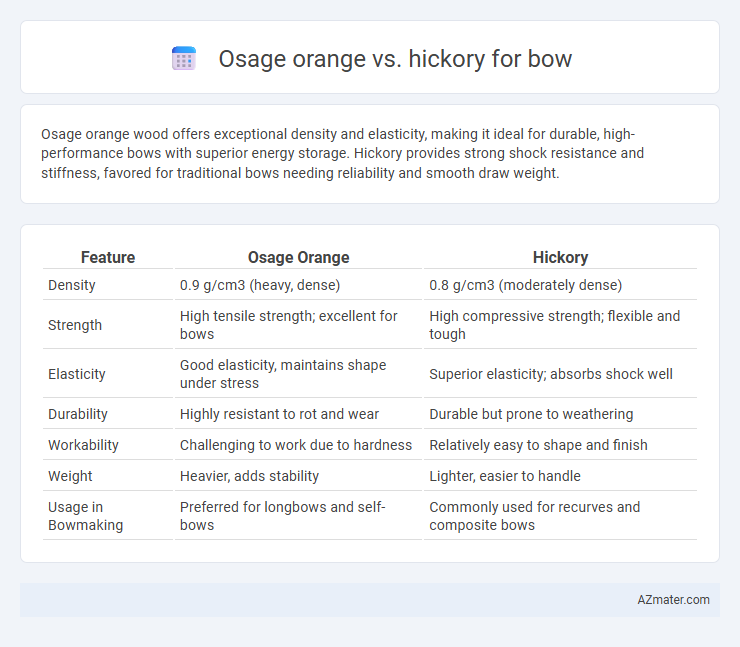Osage orange wood offers exceptional density and elasticity, making it ideal for durable, high-performance bows with superior energy storage. Hickory provides strong shock resistance and stiffness, favored for traditional bows needing reliability and smooth draw weight.
Table of Comparison
| Feature | Osage Orange | Hickory |
|---|---|---|
| Density | 0.9 g/cm3 (heavy, dense) | 0.8 g/cm3 (moderately dense) |
| Strength | High tensile strength; excellent for bows | High compressive strength; flexible and tough |
| Elasticity | Good elasticity, maintains shape under stress | Superior elasticity; absorbs shock well |
| Durability | Highly resistant to rot and wear | Durable but prone to weathering |
| Workability | Challenging to work due to hardness | Relatively easy to shape and finish |
| Weight | Heavier, adds stability | Lighter, easier to handle |
| Usage in Bowmaking | Preferred for longbows and self-bows | Commonly used for recurves and composite bows |
Introduction to Osage Orange and Hickory Woods
Osage orange (Maclura pomifera) and hickory (Carya spp.) are highly regarded woods in bowmaking due to their unique strength and flexibility properties. Osage orange is known for its dense, fine-grained texture and remarkable resistance to compression, making it ideal for traditional self bows. Hickory offers excellent shock resistance and elasticity, with a fibrous grain structure that enhances durability and performance in longbows and composite bows.
Historical Use in Traditional Bow Making
Osage orange wood was highly prized by Native American tribes for its exceptional strength, density, and natural resistance to decay, making it a preferred material for traditional bows. Hickory, known for its outstanding shock resistance and flexibility, has also been historically used by early American bowyers, especially for longbows and hunting bows. Both woods exhibit remarkable durability and performance, but Osage orange's superior tensile strength often gave it an advantage in crafting powerful, resilient bows favored in indigenous archery traditions.
Physical Properties Comparison
Osage orange wood is prized for its exceptional hardness, density around 50 lbs/ft3, and high elasticity, providing excellent tensile strength and shock resistance ideal for traditional bow making. Hickory, with a slightly lower density of approximately 43 lbs/ft3 and remarkable toughness, offers superior flexibility and impact resistance, making it suitable for longbows and bows requiring dynamic bending. Both woods feature high compression strength, but Osage orange's superior stiffness and durability often result in more efficient energy transfer and longer-lasting bows.
Flexibility and Strength of Osage Orange vs Hickory
Osage orange wood is renowned for its exceptional strength and moderate flexibility, making it one of the top choices for traditional bowmaking due to its high density and natural elasticity. Hickory, while robust and highly flexible, offers greater shock resistance and resilience but is slightly less stiff compared to Osage orange, which provides superior energy transfer for powerful, accurate shots. The denser grain structure of Osage orange contributes to its ability to store more energy, whereas hickory's toughness ensures long-term durability under repeated stress.
Durability and Longevity Under Stress
Osage orange is renowned for its exceptional durability and resistance to compression and torsion, making it one of the best bow woods for longevity under stress. Hickory offers excellent shock resistance and flexibility but is more prone to wear and environmental damage over time compared to Osage orange. Osage orange bows maintain structural integrity longer, especially under heavy use and varying conditions, ensuring superior lifespan and performance.
Workability and Ease of Shaping
Osage orange offers exceptional workability with its dense, fine-grained wood that holds sharp edges well, making it easier to shape for bowyers seeking precision and durability. Hickory, while tougher and heavier, provides good shock resistance but can be more challenging to work with due to its coarse grain and hardness, requiring sharper tools and more effort during shaping. Both woods are popular for bow-making, but Osage orange stands out for smoother carving and consistent tension properties.
Performance: Speed, Power, and Shooting Experience
Osage orange offers exceptional speed and power due to its dense, elastic fibers, making it highly responsive for fast, powerful shots in traditional archery. Hickory provides reliable strength and durability with a slightly slower speed but superior shock absorption, enhancing shooting comfort and reducing hand fatigue. The shooting experience with Osage orange feels more dynamic and energetic, while hickory offers a steadier, smoother draw and release, favored by bowyers seeking balance between strength and flexibility.
Availability and Cost Differences
Osage orange is widely available in the central United States and often costs less due to its abundance, making it a budget-friendly option for bowmakers. Hickory, prized for its strength and resilience, tends to be more expensive and less readily available outside its native regions in the eastern U.S. Cost differences arise from the slower growth rate and limited supply of quality hickory compared to the fast-growing, abundant Osage orange.
Maintenance and Care Requirements
Osage orange wood, known for its natural rot resistance and dense grain, requires minimal maintenance and is highly durable for bow making, making it ideal for hunters seeking low upkeep. Hickory, while tough and shock-resistant, needs regular oiling and protection from moisture to prevent warping and cracking, demanding more attentive care. Proper seasoning and storage in a controlled environment extend the lifespan of both woods, but Osage orange offers a more forgiving maintenance profile for long-term bow functionality.
Conclusion: Which Wood is Better for Bows?
Hickory is generally preferred for bows due to its superior strength, flexibility, and shock resistance, which provide better performance and durability. Osage orange offers excellent stiffness and natural rot resistance but can be more challenging to work with and less forgiving under heavy draw weights. For most bowyers, hickory's balance of toughness and elasticity makes it the better overall choice for crafting reliable and efficient bows.

Infographic: Osage orange vs Hickory for Bow
 azmater.com
azmater.com